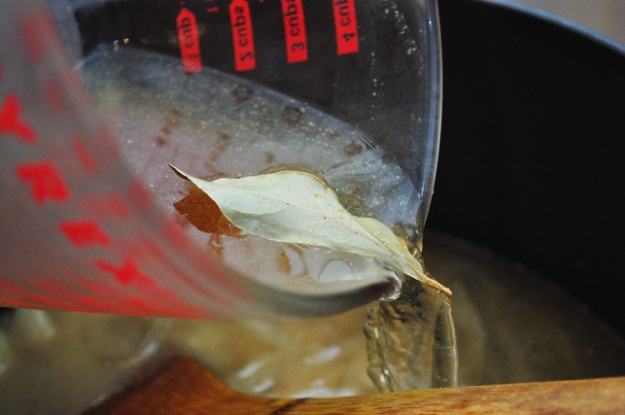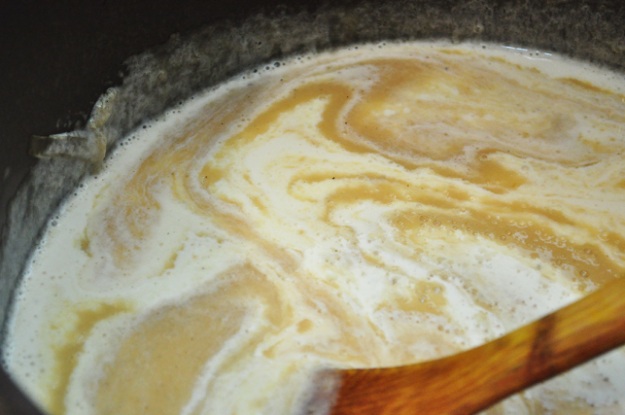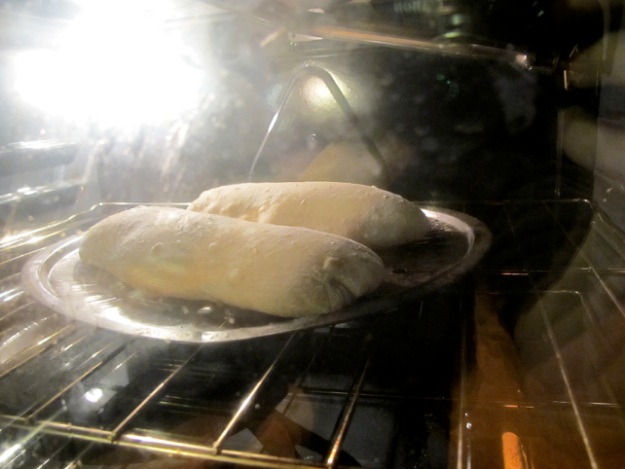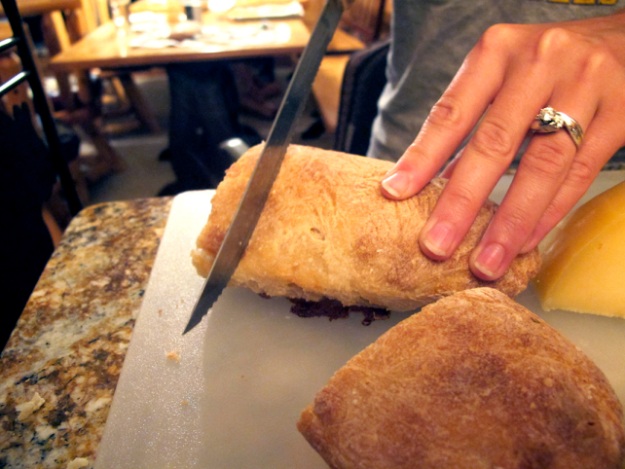 If you’ve looked at any of my recipes at all, you know one thing: I love garlic.
If you’ve looked at any of my recipes at all, you know one thing: I love garlic.
And I love cream. So that’s two things.
We could also add mushrooms in there for number three . . . and how could I forget rice?? So if you’ve looked at any of my recipes at all, you actually know four things. *Insert clever statement of your choice referencing Monty Python’s Spanish Inquisition skit*
This garlic soup recipe came to me from on high. It came via Tasty Kitchen, Pioneer Woman’s recipe sharing site. It came with angelic choruses singing in the starlit sky. It came with blazes of glory, strings of diamonds and pearls, and ribbons in its hair.
 It is g-e-w-d. That means ‘good’ in case you’re a step behind things this morning.
It is g-e-w-d. That means ‘good’ in case you’re a step behind things this morning.
I’m a step behind things this morning. But that’s another story, which my next cup of coffee with Peppermint Mocha creamer should put a lovely ending to–a lovely ending such as: “and then the girl with the saggy eyes poured herself a cup of office coffee laced with Peppermint Mocha creamer and she lived happily! Ever! After! Her eyes went from saggy to bloodshot! Then she started typing at 1,000 WPM and cranking out her morning’s work! And the people rejoiced!”
It’s the power of caffeine on a grey morning, folks.
Anyway, enough falderal. We’ve got to get this thing started or I’ll just keep jibber-jabbering all morning long and we’ll never get to the part with the soup in it. Let’s boil it down to the bare facts: cream. Garlic. Wine. Garlic. Cheese. Garlic.
Ingredients
1 TBS olive oil
1 large onion, thinly sliced
16 cloves garlic, smashed
1 c dry white wine
4 c chicken stock
1 Bay leaf
2 cups French bread, torn into pieces
3/4 c heavy whipping cream
½ cups shredded Gruyère or Parmesan
First things first: slice your onion and smash your garlic.
You can see my container of pre-peeled garlic lurking there in the background. It’s one of the many delights provided by my local Asian grocery store.
Now heat the oil in a large pot and add the onion and garlic.
 Cook over medium heat for 10 to 12 minutes, by the end of which they will start to get goldeny brown. It’s called caramelization and it’s the greatest culinary technique in creation.
Cook over medium heat for 10 to 12 minutes, by the end of which they will start to get goldeny brown. It’s called caramelization and it’s the greatest culinary technique in creation.
Make sure your wine bottle is open. This funky opener was made for girls like me, who have broken corks untold with traditional bottle openers. It’s called a rabbit, and it would be a great Christmas gift for the struggling wine-opener in your family.

 Add the white wine and cover the pot.
Add the white wine and cover the pot.
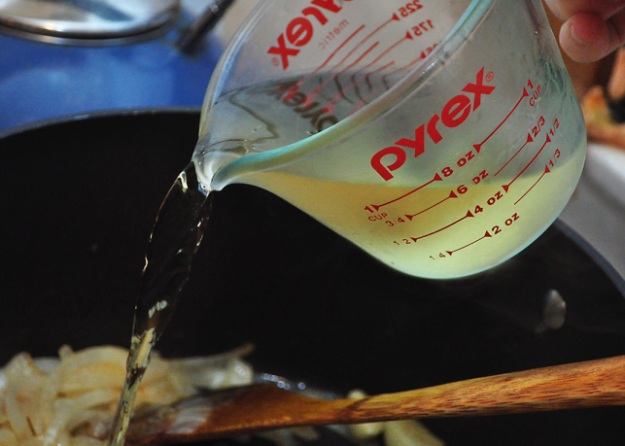 Reduce the heat to low, and cook for 10 minutes, giving it a stir every now and then.
Reduce the heat to low, and cook for 10 minutes, giving it a stir every now and then.
It’s now looking something like this, and smelling like your wildest dreams come true.
 Pour in the chicken stock and the bay leaf–you could easily use vegetable stock to make this dish vegetarian.
Pour in the chicken stock and the bay leaf–you could easily use vegetable stock to make this dish vegetarian.
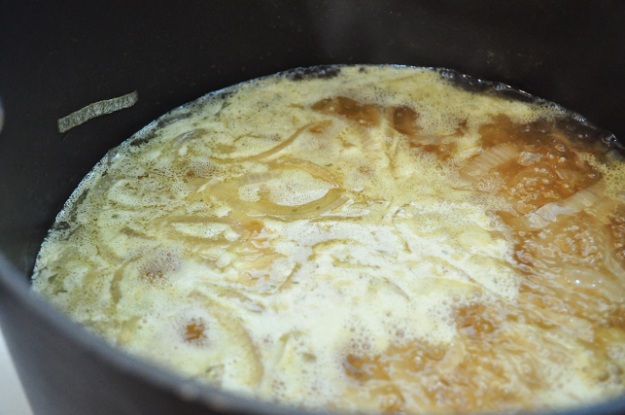 . . . then cover the pot and simmer it over low heat for 30 minutes.
. . . then cover the pot and simmer it over low heat for 30 minutes.
I used this time to tear up my bread, grate my Parmesan, and measure out my cream.
Yes, it’s my Parmesan and my cream. Not the cream. Mine, mine, mine!! All mine!!! Though I will kindly share the cellulitis with you.
 Yes, I cheated and used Parmesan even though I specifically used ‘Gruyère’ in the recipe title. But have you seen the prices on Gruyère these days? Have you seen them? And the Parmesan was on sale for $3.49 a wedge! They made me do it!
Yes, I cheated and used Parmesan even though I specifically used ‘Gruyère’ in the recipe title. But have you seen the prices on Gruyère these days? Have you seen them? And the Parmesan was on sale for $3.49 a wedge! They made me do it!
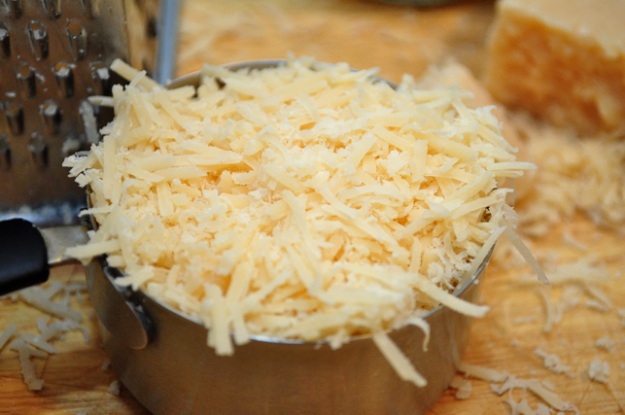 Try not to consume all the bread and parmesan before its time.
Try not to consume all the bread and parmesan before its time.
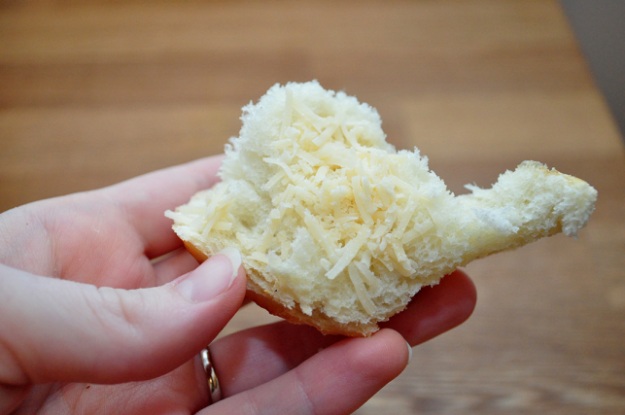 After those 30 minutes are up, turn off the stove and add the torn bread pieces . . .
After those 30 minutes are up, turn off the stove and add the torn bread pieces . . .
 . . . cover the pot and let it sit for 10 minutes. The bread will get mushy and schmushy–don’t question the process. Just believe.
. . . cover the pot and let it sit for 10 minutes. The bread will get mushy and schmushy–don’t question the process. Just believe.
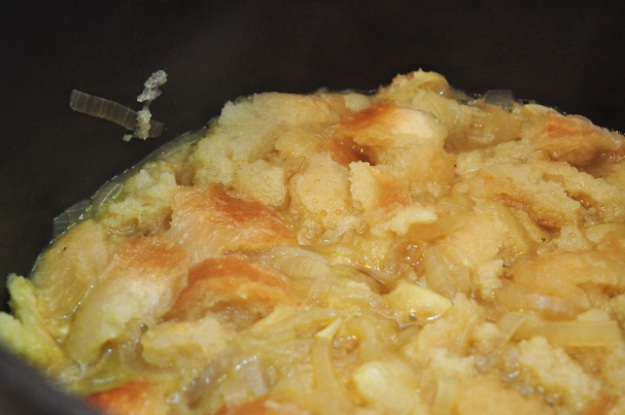
Take the bay leaf out and try not to wonder why it’s glimmering like gold. Is it a leaf from Loth-Lorien?
 I think Galadriel would totally dig this soup, yo.
I think Galadriel would totally dig this soup, yo.
Now put your immersion blender in and puree this baby.

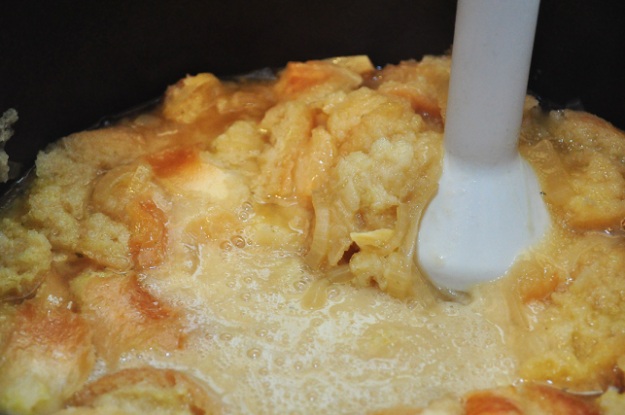 You can also pour the soup into a regular blender (working in batches) and whizz it there, but make sure not to hurt or burn yourself in the process. I’ve heard stories of exploding soups and I want to make sure those do not take place in your life or kitchen.
You can also pour the soup into a regular blender (working in batches) and whizz it there, but make sure not to hurt or burn yourself in the process. I’ve heard stories of exploding soups and I want to make sure those do not take place in your life or kitchen.
Puree the soup until it’s nice and smooth, then stir in the cream . . .
. . . and add generous amounts of black pepper, and salt to taste. Taste it a few times. And then a few more. I know I certainly did.
Garnish each bowl with a hefty sprinkling of cheese. I added green onions for color.
Enjoy!
Click here for printer-friendly version: Garlic Gruyère Soup


